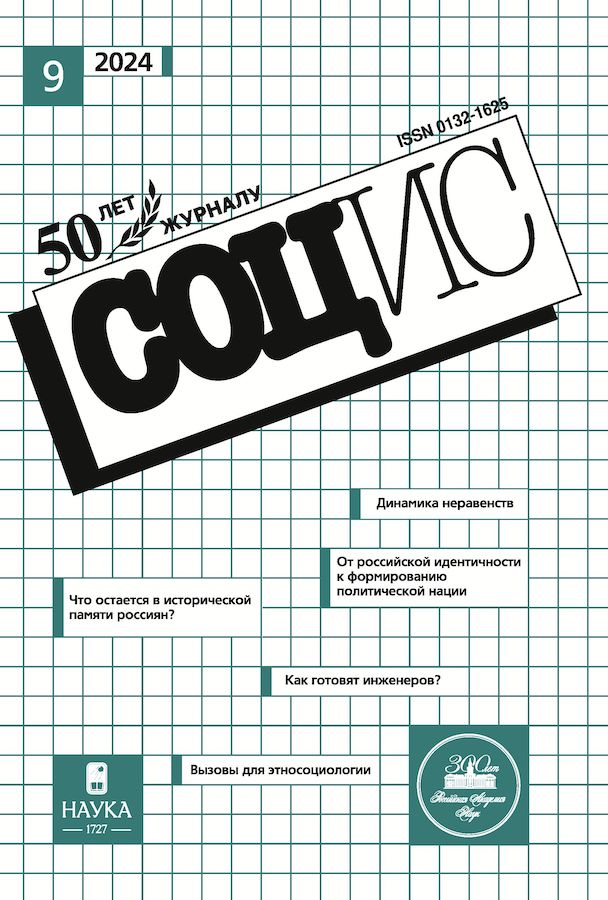Dynamics of Changing Profile of Russian Identity in 2021–2023 (the case of the Republic of Sakha (Yakutia))
- Authors: Kuznetsov I.M.1
-
Affiliations:
- Institute of Sociology of FCTAS RAS
- Issue: No 9 (2024)
- Pages: 67-78
- Section: ЭТНОСОЦИОЛОГИЯ
- URL: https://clinpractice.ru/0132-1625/article/view/661926
- DOI: https://doi.org/10.31857/S0132162524090066
- ID: 661926
Cite item
Abstract
The article presents the first results of applying a multidimensional approach to studying dynamic changes in various aspects of Russian civil identity in 2021–23. It uses a technique based on a five-component model for measuring group identification developed by K. Leach et al. The empirical base for the study is data from a survey conducted among residents of the Sakha Republic (Yakutia). Based on the analysis of the results, the author concludes that 2022 was a period of social and political turbulence, during which there was a rethinking of both the sense of belonging to Russian society and the perception of it as an integral entity. The most significant events for all generations of Russians were discussions and conflicts on issues related to belonging, commitment to, or at least loyalty towards, the Russian community, its values, norms, and historical path. In 2023, the process of the Russian community consolidation became dominant, as evidenced by the growing indicators of all dimensions of Russian identity above the average. The most active growth was seen in groups with high self-esteem in those identity parameters that reflect individual efforts to rethink and inform a personal attitude towards the Russian community. While, according to parameters that rather reflect the formation of a generalized image of the Russian community as a whole in the information environment (including images transmit through social networks, mass media, texts of fiction, theatrical productions, cinematography, TV etc.), the increase in groups with high values was less significant.
Full Text
About the authors
Igor M. Kuznetsov
Institute of Sociology of FCTAS RAS
Author for correspondence.
Email: ingvar31@yandex.ru
Cand. Sci. (Sociol.), Leading Research Fellow
Russian Federation, MoscowReferences
- Agadullina E. R., Lovakov A. V. (2013) Measurement Model of In-group Identification: Validation in Russian Samples. Psihologiya. Zhurnal Vysshei shkoly ekonomiki [Psychology. Journal of Higher School of Economics]. Vol. 10(4): 139–153. doi: 10.17323/1813-8918-2013-4-143-157. (In Russ.)
- Ashmore R. D., Deaux K., McLaughlin-Volpe T. (2004) An Oorganizing Framework for Collective Identity: Articulation and Significance of Multidimensionality. Psychological Bulletin. Vol. 130. No. 1: 80–114. doi: 10.1037/0033-2909.130.1.80.
- Crocker J., Luhtanen R. (1990). Collective Self-esteem and Ingroup Bias. Journal of Personality and Social Psychology. Vol. 58. No. 1: 60–67. doi: 10.1037/0022-3514.58.1.60.
- David O., Bar-Tal D. A (2009) Sociopsychological Conception of Collective Identity: The Case of National Identity as an Example. Personality and Social Psychology Review. Vol. 13. No. 3: 354–379. doi: 10.1177/1088868309344412.
- Durkheim E. (1996) The Division of Labor in Society. Moscow: Kanon. (In Russ.)
- Ellemers N., Kortekaas P., Ouwerkerk J. W. (1999) Self-categorization, Commitment to the Group and Group Self-esteem as Related but Distinct Aspects of Social Identity. European Journal of Social Psychology. Vol. 29: 371–389. doi: 10.1002/(SICI)1099-0992(199903/05)29:2/33.3.CO;2-L.
- Ellemers N., Spears R., Doosje B. (2002) Self and social identity. Annual review of psychology. Vol. 53: 161–186. doi: 10.1146/annurev.psych.53.100901.135228.
- Erikson E. H. (1996) Identity: Youth and crisis. Moscow: Progress. (In Russ.)
- Khukhlaev O. Ye., Aleksandrova E. A. et al. (2019) Religious Group Identification and Ethno-National Attitudes in Buddhist, Muslim and Orthodox Youth. Кulturno-istoricheskaya psikhologiya [Cultural Historical Psychology]. Vol. 15(3): 71–82. doi: 10.17759/chp.2019150308. (In Russ.).
- Kuznetsov I. M. (2023) Patriotism of the regional youth in the sociological dimension (case of the Penza region). Sociologicheskaja nauka i social’naja praktika [Sociological science and social practice]. Vol. 11. No. 2: 25–40. doi: 10.19181/snsp.2023.11.2.2. (In Russ.)
- Leach C. W., van Zomeren M. et al. (2008) Group-level Self-definition and Self-investment: A Hierarchical (Multi-component) Model of Ingroup Identification. Journal of Personality and Social Psychology. Vol. 95. No. 1: 144–165. doi: 10.1037/0022-3514.95.1.144.
- Lickel B., Hamilton D. L. et al. (2000) Varieties of Groups and the Perception of Group Entitativity. Journal of Personality and Social Psychology. Vol. 78. No. 2: 223–246. doi: 10.1037//0022-3514.78.2.223.
- Ryzhova S. V. (2023) The Ethno-sociological School of L. Drobizheva: Developing Approaches towards the Study of all-Russian Identity. Sotsiologicheskiy zhurnal [Russian Sociological Journal]. Vol. 29. No. 1: 36–54. doi: 10.19181/socjour.2023.29.1.2. (In Russ.)
- Tajfel H. (1981) Human Groups and Social Categories: Studies in Social Psychology. Cambridge, UK: Cambridge University Press.
Supplementary files














